Including one photo where his gorget is fully lit up in all its glory.
I’m almost certain that this is the same male Broad-tailed Hummingbird I posted photos of yesterday as he took off in pursuit of another hummingbird that had invaded his patch in the Wasatch Mountains. In this short series he’s doing it again. This takeoff may not be quite as dramatic as the previous one but I still think it’s worth a look.
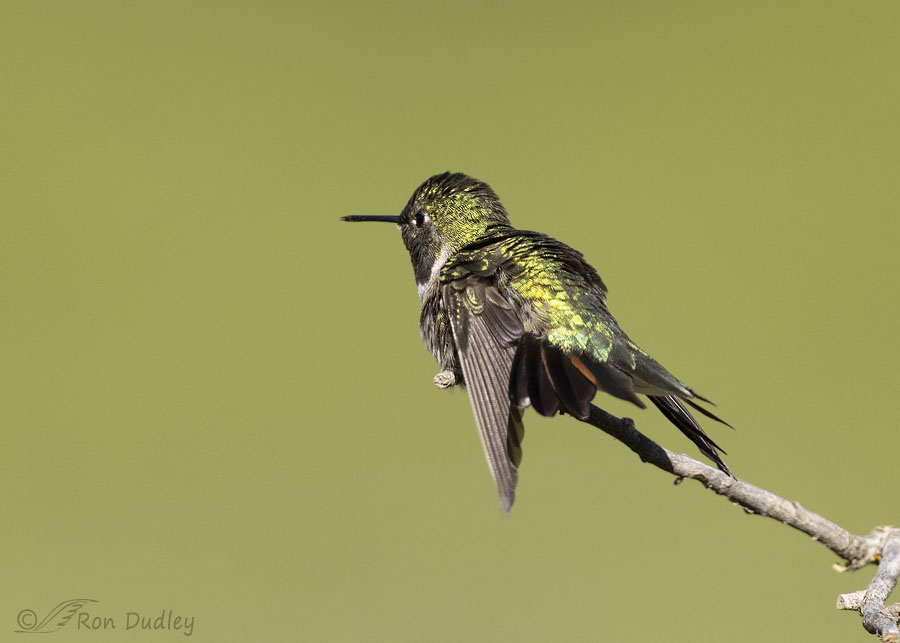
1/4000, f/5.6, ISO 800, Canon R5, Canon EF500mm f/4L IS II USM + 1.4 tc, not baited, set up or called in
This is one of several high perches he used to guard over his patch. When he landed here he had his back to me so at first I wasn’t taking any photos. But when he struck this pose, which I believe (though I’m not certain) is a threat posture directed at another incoming hummingbird, I fired off a burst to see if I could capture whatever might happen.
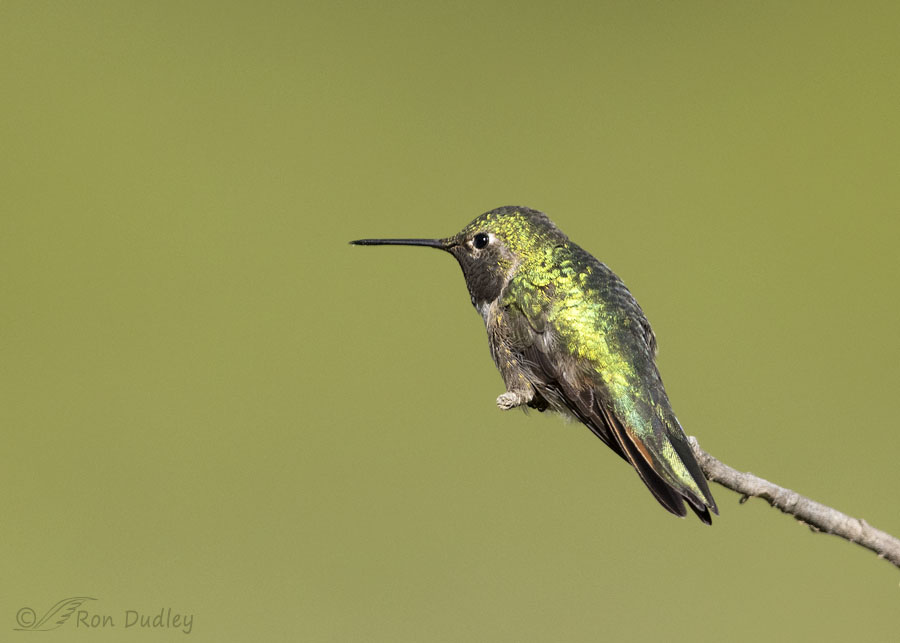
1/5000, f/5.6, ISO 800, Canon R5, Canon EF500mm f/4L IS II USM + 1.4 tc, not baited, set up or called in
Three frames later he had flattened his feathers, likely in preparation for potential action. It was roughly at this point that I once again heard, but did not see, another hummer fly from left to right in front of me.
What you see in this photo and the following two took less than two tenths of a second (.167 seconds) to occur.
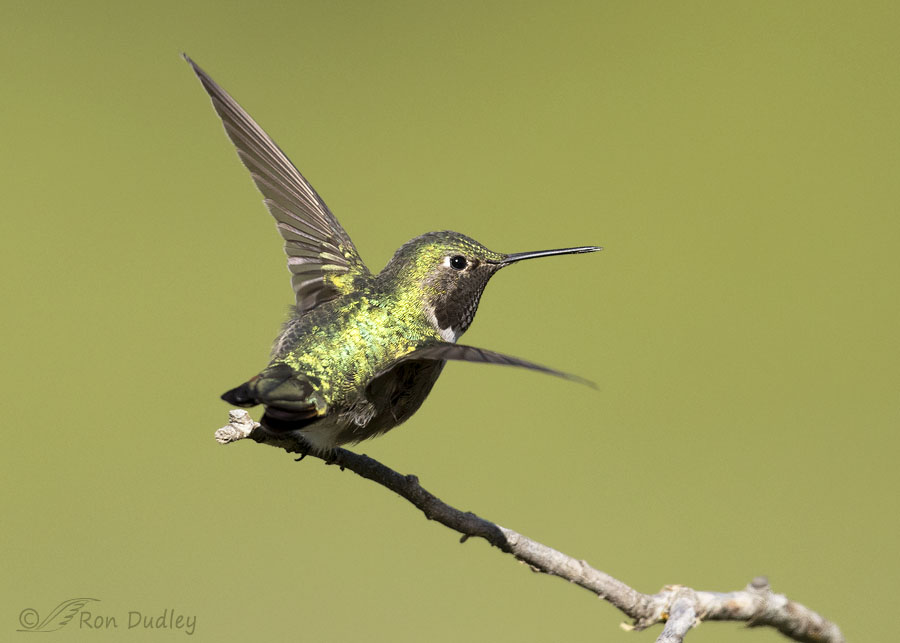
1/5000, f/5.6, ISO 800, Canon R5, Canon EF500mm f/4L IS II USM + 1.4 tc, not baited, set up or called in
The trespassing hummer passed from left to right in front of this guy so in an instant he twisted more than 90° on his perch and…
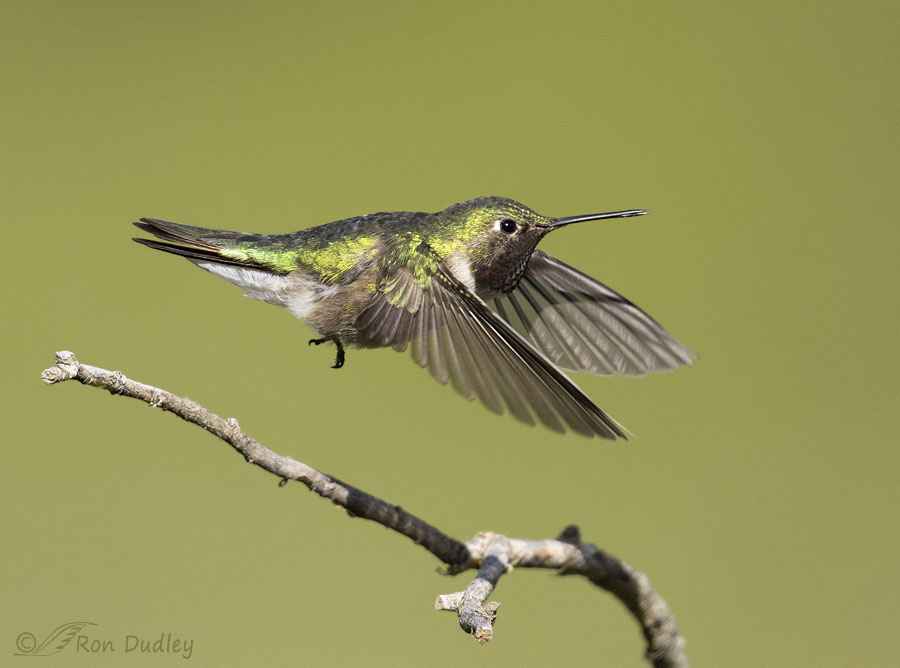
1/5000, f/5.6, ISO 800, Canon R5, Canon EF500mm f/4L IS II USM + 1.4 tc, not baited, set up or called in
took off in pursuit of the cheeky interloper.
For some reason, at this point I took my finger off of the shutter button so this is the last shot I got of him in flight. I like this photo for a lot of reasons, including his position in the frame relative to the perch. I took a lot of shots of him while he was perched on various high twigs and branches but his favorite perch was a little too far away for high quality photos.
One of the most frustrating things about photographing hummingbirds occurs when you’re trying to capture all of the blazing color of their iridescent gorget. It’s frustrating because to get the full iridescent gorget display the hummer usually has to be facing you and looking in your direction, which makes their bill essentially disappear and also makes it difficult to get a catch light in either eye. If the light doesn’t hit the gorget just right, there’s no iridescence.
But I got lucky one time with what I believe was this same hummingbird.
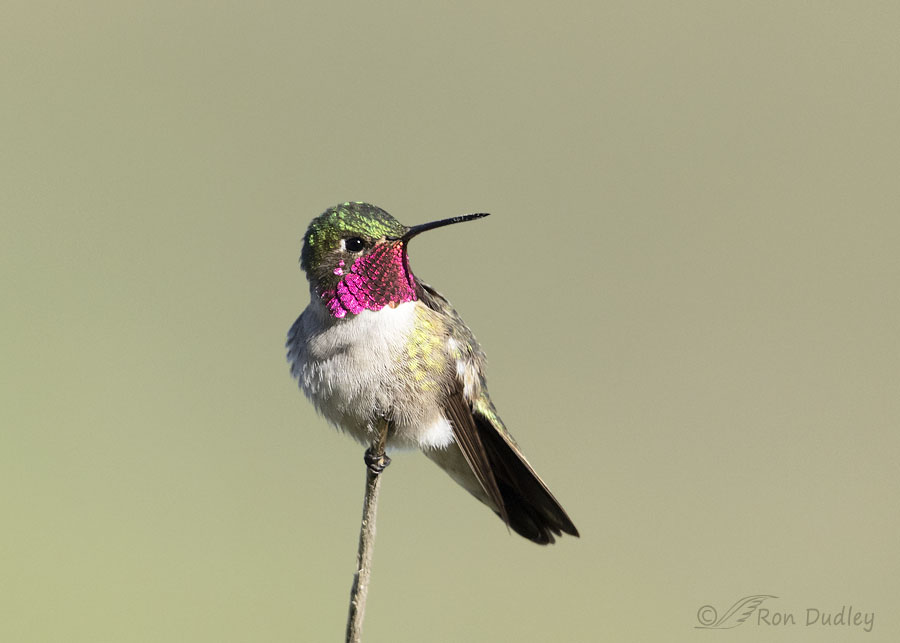
1/2500, f/6.3, ISO 800, Canon R5, Canon EF500mm f/4L IS II USM + 1.4 tc, not baited, set up or called in
In this one shot out of many he had his head turned so there’s light in his eye and his bill is easily seen in profile, at the same time his gorget was lit up like fire. I’m not sure how it happened but I’ll take it.
I just wish he’d been closer. This image has been cropped significantly.
Ron


Great pictures and blow-by-blow narration
All excellent Ron. I have never knowingly seen a Broad-tailed although quite possibly I have. I am not good at Hummer ID. In your experience with these Broad-tailed, do you think they defend their territory as fiercely as the Ruffous Hummers do?
Everett, Rufous have the reptuation of being our most pugnacious hummer and nothing I’ve seen disputes that.
Am I right in thinking that hummingbirds (the males at least) suffer from short man syndrome? At least one of my brothers does and he doesn’t look nearly as attractive. (and is intensely irritated because I am taller than all of them).
Another truly delightful series. Thank you.
EC, in hummers both sexes have SMD but the males have it in spades.
“Flying jewels” — even when they’re in attack mode! Excellent captures, Ron, the iridescence of all those feathers, especially the rose-colored gorget, is incandescent!
Chris, I agree with all you said about them.
The feathers on his back, especially in the third photo, look like something Monet might have painted, with the greens and yellows reminiscent of something not quite definable. Again, the backgrounds really work for these photos.
Thanks, Lyle. I’ll have to brush up on my Monet to really understand your comparison.
Must be something in the water:
https://uploads3.wikiart.org/images/claude-monet/houses-of-parliament.jpg-
“404 – File not found”
But I did my own search and I see what you mean.
Thanks Lyle! i just wrote a long comment (well I COPIED a long thing from Wikipedia) below
Wow, he’s a quick-change artist! A quick dip offstage, then back onstage with his pink sparkler gorget (gorgeous!) for the grand finale! His grumpy expression in #2 makes me laugh, as do his impossibly tiny feet.
Carolyn, I’m convinced these guys were born (hatched) grumpy.
The last on is a stunner. I had another one in my sites that morning and yes he was far away too.
At least you got the sapsucker to make up for it. Thanks, April.
Ron,
Remarkable!
Stephen
Thanks, Stephen.
You, Lyle, and the hummer (or zumbador as my friend in Puerto Rico calls them) have sent me down quite a rabbit hole. Yes his back looks like the Thames! Never ever would I have thought of that. Here is something else interesting, copied from Wikipedia, and relevant to those of us in the Northeast enjoying sunsets and sunrises as we cough and choke in the fine particulates of the fires in Quebec and Nova Scotia:
stylistic changes from more figurative to impressionistic paintings by Turner and Monet over the 19th century strongly covary with increasing levels of air pollution. In particular, stylistic changes in their work toward hazier contours and a whiter color palette are consistent with the optical changes expected from higher atmospheric aerosol concentrations. These results indicate that Turner and Monet’s paintings capture elements of the atmospheric environmental transformation during the Industrial Revolution
I actually find that quite interesting, Frances. Thanks for going to the trouble to share it.
Beautiful Hummingbird image set, Ron!! Glad you caught the flight shot on take off, looks stellar with the wings down position.
Thank you, Chris.
Not only his gorget, but all of his other iridescent feathers are the most perfectly
gleaming and crisply defined I’ve ever seen–I’m wondering if he found a place to bathe recently, or if he’s very young, or both—spectacular !
Kris, there’s a seep quite close to where this bird was (below him and to our left) but I don’t think he was wet while I was with him. He was so busy chasing off intruders I doubt he had time or opportunity to bathe.
Beautiful! Amazing how different the gortet looks depending on the lighting.
They ARE territorial when it comes to feeders here.
Thanks, Judy. When it comes to hummingbirds, “territorial” is an understatement.
Ohhh OK I’m in luv with a bird today… these photos are great!
Thank you, CJ.
so beautiful! and this post sent me to check my assumption about the etymology of the word ‘gorget’—–I guessed French. Close. Middle English (think Chaucer) from Old French. In other words, a word added to the English language after 1066 when the Normans brought French to the court. Originally it described a piece of armor that protected the neck.
Once again, the biology teacher and the English teacher find common ground.
Thanks, Sue. The two of us never had trouble finding common ground. 53 years later we still don’t.